Sourwood Tree (Oxydendrum arboreum): Leaves, Bark, Flowers – Identification Guide (With Pictures)

The sourwood tree is an ornamental deciduous small tree famous for its white flowers, lanceolate leaves, gray-brown patterned bark, and red fall leaves. The attractive features of a sourwood tree are its pretty urn-shaped white flower clusters (panicles), stunning foliage that turns shades of crimson-red to reddish-purple color in the fall, and attractive red-brown bark. Sourwood is a beautiful decorative tree suitable for growing in full sun to partial shade in residential garden landscapes.
This article is a comprehensive guide to growing a sourwood landscape tree in your front or backyard. Descriptions and pictures of sourwood flowers, leaves, and fruit will help you see where to plant this stunning specimen tree.
Sourwood Tree (Oxydendrum Arboreum) Facts

Sourwood tree (Oxydendrum arboreum) with red leaves in the autumn.
Sourwood (Oxydendrum arboreum) is a small deciduous tree in the heath family Ericaceae. This native tree grows throughout the Eastern United States from Florida, Louisiana, and North Carolina north to Pennsylvania. Although moderately tolerant of salt, it doesn’t perform well in drought or polluted environments.
Sourwood trees are relatively small, slow-growing, and reach 20 to 30 ft. (6 – 10 m) tall and wide. The tree’s characteristic growth habits are a slender trunk, narrow, irregular crown, and branches that droop slightly. Additionally, the tree produces small urn-shaped flowers that look like lily-of-the-valley flowers. Its fall color is a spectacular deep red.
A sourwood tree can live for 75 to 100 years with the proper care and attention.
Also called the sorrel tree, a unique feature of the sourwood tree is that it’s the only species in the Oxydendrum genus. Additionally, the native tree does not grow in the wild in other countries apart from the United States.
The name sourwood comes from the tree’s bitter yet edible foliage. The botanical name means acidic tree. The leaves provide a tangy, tart flavor to stews when cooked. Similarly, the edible white sourwood flowers have a fresh, acidic taste. Also, the sweet aroma of the flowers attracts bees that feed on the sweet nectar.
Another name for the sourwood tree is the lily of the valley tree—this is because the bell-shaped flowers look like those of lily of the valley plant (Convallaria majalis).
One of the most well-known products from the sourwood tree is the hard-to-find and incredibly delicious honey. The gourmet honey has a sweet buttery caramel flavor with a slightly peppery aftertaste. The amber-colored sourwood honey also has an aroma of cinnamon and cloves. Because of its famous honey, sourwood is also called the honey tree.
Sourwood Tree Leaves
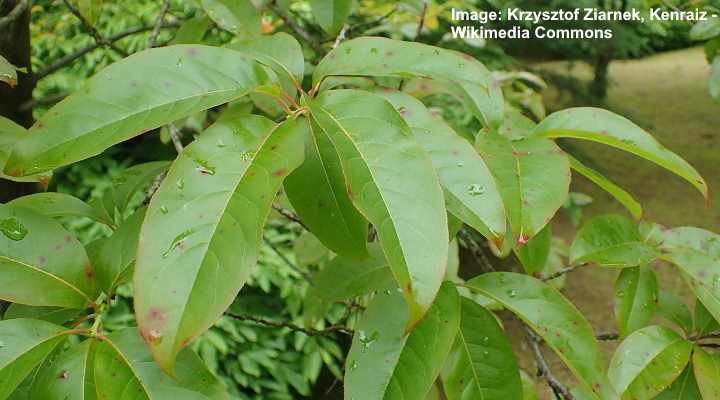
Sourwood tree leaves
Leaves from the sourwood tree are identified as lance-shaped with pointed tips and measure 3” to 6” (7.5 – 15 cm) long and up to 3” (7.5 cm) wide. Sourwood leaves look like laurel leaves with finely toothed margins. The simple leaves have a conspicuous midrib and fine feather-like veining.
The sour-tasting leaves have short petioles and grow alternately on the tree’s stems. It’s said that sourwood leaves taste like sour apples.
Sourwood trees are easy to identify in the fall due to their brilliant colors. In autumn, sourwood leaves develop colorful fall foliage in vibrant shades of crimson red to burgundy and purple. The bright red colors stand out from other deciduous landscape trees that may be golden yellow or coppery-bronze.
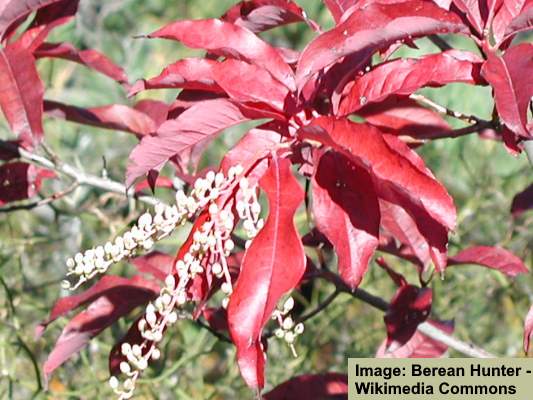
Sourwood tree leaves in autumn
Sourwood Tree Bark
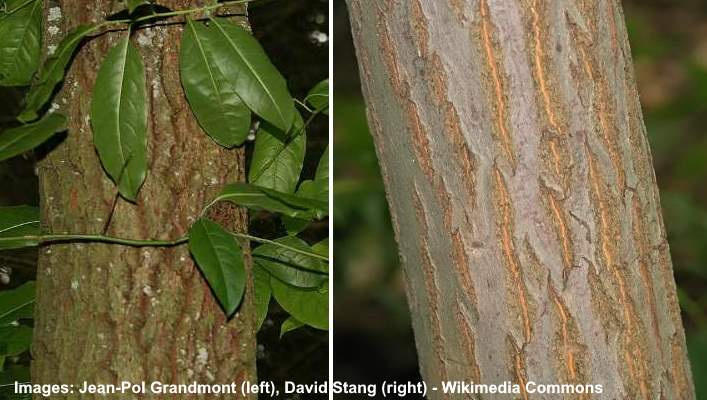
Sourwood tree bark
Gray bark with reddish tinges helps to identify sourwood trees. The bark develops deep furrows and scaly patterns like the alligator hide-type bark of black tupelo trees. An interesting feature of sourwood tree bark is that twigs and branches emerge bright red before turning gray.
Sourwood Tree Flowers
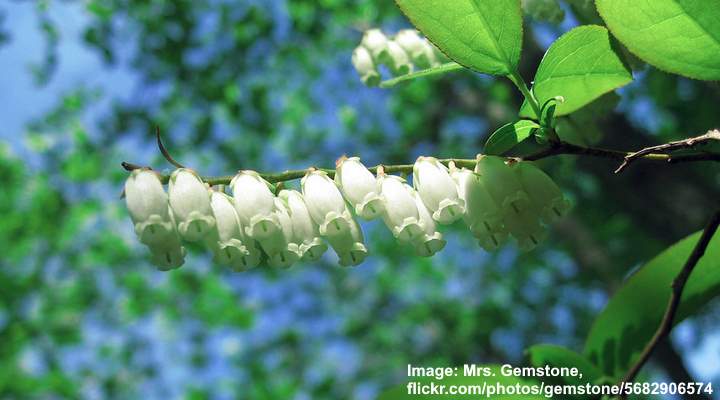
Sourwood tree flowers
Flowers on sourwood trees are panicles of creamy-white, urn-shaped flowers that grow on one side of the stems and bloom in June and July. The slender clusters of bell-like flowers measure 4” to 8” (10 – 20 cm) long. Each scented flower consists of five tiny petals fused to create a little bell.
The abundant fragrant flowers give the sourwood tree a soft textured appearance when blooming in midsummer. The flower panicles are long and slender and can curve upward, with the urn-shaped flowers dangling downward.
The nectar-laden flowers are also a source of honey. Honeybees pollinate the flowers and feed on the sweet nectar. The amazing honey from sourwood blossoms has a spicy aroma, sweet caramel taste, and pleasant aftertaste.
Sourwood Tree Fruit
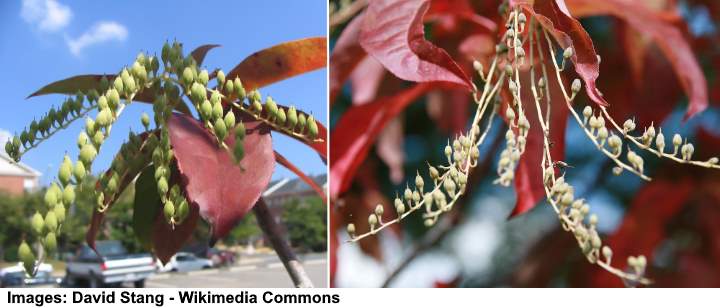
Sourwood tree fruit: immature (left) and mature (right)
Fruits on sourwood trees are small oval, egg-shaped capsules with a yellowish or greenish color that mature to grayish-brown color. The hairy capsules ripen in late fall and contain tiny seeds. In autumn, you can recognize the sourwood tree by the rows of brown fruit standing erect on curving stems.
Sourwood tree fruit persists on the tree until winter. The brownish capsules measure up to 0.5” (1.2 cm) long and provide visual ornamental interest contrasting with the vibrantly colored red foliage.
Sourwood Tree Identification
Sourwood tree can be identified by its flowers, leaves, and bark. Sourwood tree can be identified by its large, glossy green lanceolate leaves that turn bright red to reddish-purple color in the fall. During summer, long panicles of distinctive creamy-white bell-shaped fragrant flowers help to identify the tree. Sourwood tree bark has recognizable deep furrows with patterns resembling alligator hide.
Sourwood Tree Landscape Uses
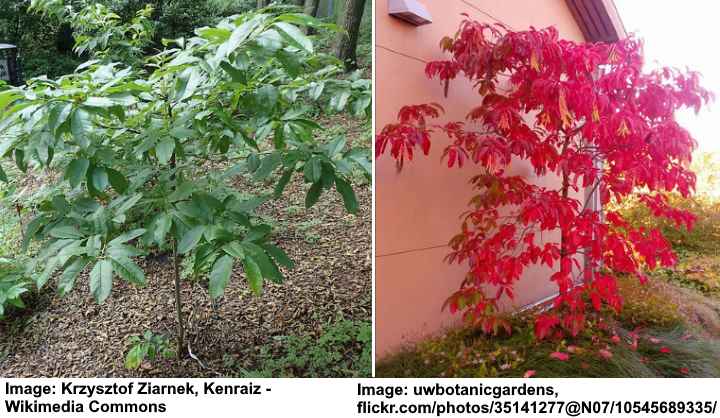
Young sourwood trees with green and red leaves
Native sourwood trees are beautiful ornamental trees that provide visual interest in all seasons. The dense, glossy green foliage appears in spring, and the branches have a somewhat weeping or drooping habit. Then by summer, the tree is in bloom with rows of beautiful urn-shaped flowers. By fall, brilliant red foliage covers the branches.
Small sourwood trees are usually planted as specimen trees to provide multi-season interest. The trees with their weeping branches and irregular pyramidal crown are ideal for lawns, shade gardens, or patios. In addition, its attractive summer green and white colors and excellent fall colors create a focal point throughout the growing seasons.
Because sourwoods grow well in partial shade, they are excellent under-story trees. In addition, their relatively short stature provides plenty of interest at eye level and can be a great addition to your landscape.
There are two issues to consider when using sourwood trees in the landscape. First, the trees don’t tolerate urban pollution and won’t thrive in city environments. Second, the trees don’t perform well in compact soil or cope with drought.
Where to Plant Sourwood Tree
Plant the sourwood tree in full sun in a location that gets at least six hours of sunlight daily. Choose a location with well-draining, slightly acidic soil to plant a sourwood tree. Ideally, the planting location should be rich in organic content that holds enough moisture without becoming too soggy.
Sourwood trees are hardy in USDA zones 5 through 9. This means that with the proper care, you can grow the landscape trees in states like Florida, Texas, and the Carolinas and as far north as Iowa, Illinois, and New York State.
How to Plant Sourwood Tree
To plant a sourwood tree, dig a hole twice as wide as the tree’s root ball and the same depth. Then remove the rooted nursery plant from the container and untangle the roots. Place the young tree in the center, ensuring that it grows at the same height as before. Finally, backfill the hole using the amended native soil.
After filling the hole, press down the soil to remove air pockets and thoroughly water the ground. Lastly, add a 2” to 3” (5 – 7.5 cm) layer of organic mulch to help keep the soil moist and control weeds.
When planting a sourwood tree, ensure that the soil is organically rich, acidic, and drains well. Then make sure that the location is in full sun for best results. You can then dig your hole for planting a sourwood tree. It helps to amend the soil with compost to increase acidity and add sand or gravel to improve drainage.
Sourwood Tree (Oxydendrum arboreum) Care Guide
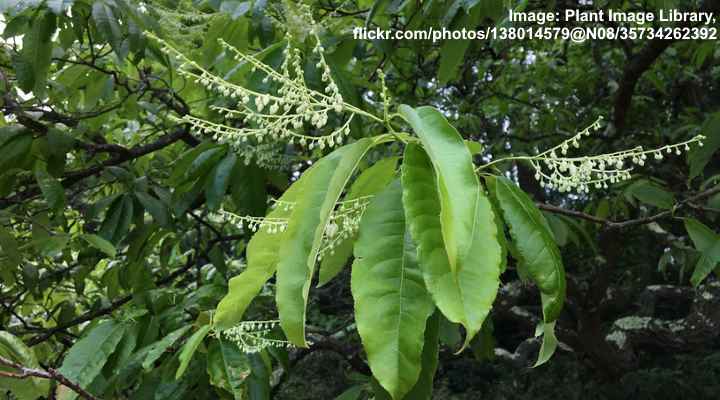
To care properly for sourwood tree, it requires well-drained organically rich acidic soil and full sun for best results
To grow Oxydendrum arboreum, keep the ground well-watered during dry spells. Provide additional fertilizer in late fall to increase the soil’s nutrient content. Then it’s vital to prune the sourwood tree in early spring to encourage new growth and maintain its shape.
Let’s look in more detail at caring for a sourwood tree.
How to Water Sourwood Tree
Water a sourwood tree often enough to prevent the ground from drying out. Sourwoods are not drought-tolerant plants and require plenty of moisture during the growing seasons. The best way to water the tree is to apply a trickle of water over several hours to irrigate the roots thoroughly.
Sourwood Tree Fertilization
Sourwood trees can benefit from fertilization once a year in late fall. To ensure healthy growth, it’s vital to choose a fertilizer for acid-loving trees. You can also use a tree fertilizer with an NPK rating of 10-10-10. Additionally, use nitrate-based fertilizer because ammonium ones will burn the roots.
Another way to ensure a sourwood tree gets enough nutrients is to apply rotted manure or organic compost every spring. This type of natural fertilizer helps increase the soil’s acidic content, which is what sourwood trees prefer.
Pruning Sourwood Tree
Sourwood trees require minimal pruning when established. You should remove dead or decaying branches in early spring. Additionally, it’s helpful to remove any suckers or branches that grow near the trunk’s base. Most of the critical pruning for sourwoods is when the trees are relatively immature.
It’s vital to prune a sourwood tree when it’s young to help develop an attractive shape. It would be best to trim off weak-looking branches to leave five to eight evenly spaced branches. Also, remove limbs off the tree to keep a 5 ft. (1.5 m) space under the canopy.
How to Propagate Sourwood Tree
The best way to propagate sourwood trees is by collecting seeds, but even then, the seeds can be difficult to germinate. Reports show that using stem cuttings to propagate a sourwood rarely succeeds. Instead, you can collect the seeds from the brown seed capsules and start to germinate them in January.
To propagate a sourwood tree from seed, you need a seedling tray filled with a moist potting medium. For example, equal parts perlite and peat moss are ideal. Then sprinkle the fine seeds over the soil, mist with water, and cover with plastic.
Keep the seedling tray in a warm place and under a fluorescent lamp for 24 hours a day. It should take three to four weeks for germination to happen. Once the seedlings appear, apply a diluted acidic fertilizer for seedlings every two weeks. After the seedlings have developed two leaves, keep only the strongest ones and discard the rest.
After the danger of frost has passed in spring and the seedlings are at least 6” (15 cm) tall, place the seedling tray in a shaded area in your garden. After two weeks, you can transplant the seedlings to the ground.
Choose the sunniest part of your garden and ensure that the soil is loamy and well-draining.
Pests Affecting Sourwood Tree Growth
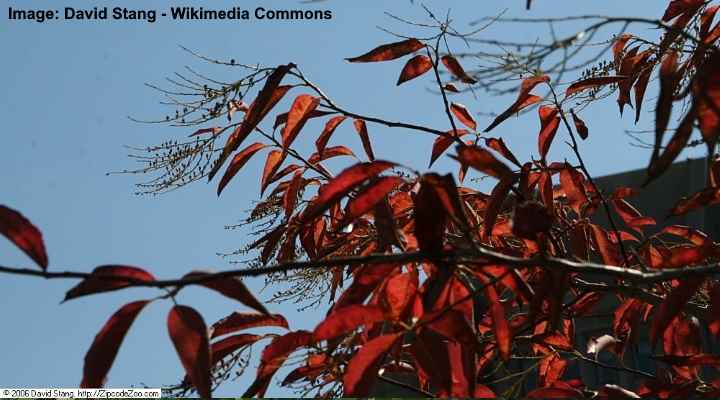
The main types of pests affecting a sourwood tree are borers, weevils, webworms, and caterpillars. Plant damage by borers like the dogwood twig borers or azalea stem borers can cause new twigs to die off or leaves to curl downward. Caterpillar damage usually results in leaf loss.
Twig borers lay eggs in the tree’s stems, and when the larvae hatch, they feed on new tissue growth inside the branches. Unfortunately, this feeding habit causes new sprouts and stems to die back, resulting in poor growth.
A type of brown beetle (Oncideres cingulata) feeds on new bark, killing twigs. Also, weevils (Conotrachelus anaglypticus) can damage new growth like buds, shoots, and leaves.
Webworm and caterpillar activity can result in tree defoliation. Webworms create web nests on the ends of branches and come out to feed on the tender leaves. Similarly, the hickory horned devil caterpillar can attack sourwood leaves in late spring.
Getting rid of borers that infest a sourwood tree can be challenging. Usually, it’s best to call in professionals to deal with the pest problem.
To get rid of webworms, you can cut the webs open to expose the larvae to birds that feed on them. Alternatively, you can cut the webs down and drop them in a bucket of soapy water to kill the caterpillars.
The hickory horned devil caterpillar is a huge green caterpillar that looks aggressive but is harmless and won’t bite you. However, it can do significant damage to your tree’s leaves. The best way to get rid of caterpillars is to handpick them and kill them in soapy water.
Diseases Affecting Sourwood Tree Growth
Several fungal diseases can affect the growth of a sourwood tree. Depending on the fungal infection, cankers can form on the twigs or branches, or leaf spots can appear on the foliage. However, ensuring the sourwood tree gets plenty of sunlight and adequate water should make it resistant to most diseases.
Small creamy white or red lesions on branches could be a sign of nectria canker (Nectria galligena). This slowly spreading fungal infection can cause die-back where new growth doesn’t appear or leaves wilt suddenly. The best way to deal with canker diseases is to prune and destroy infected limbs.

Nectria canker (Nectria galligena)
Too much cool air, humidity, and ground moisture can cause leaf spot fungi to affect foliage. The foliar diseases appear as brown spots on leaves that quickly spread to the whole leaf. The best way to prevent leaf spot is to avoid overwatering a sourwood tree and ensure it gets plenty of sunlight.
Related articles:
